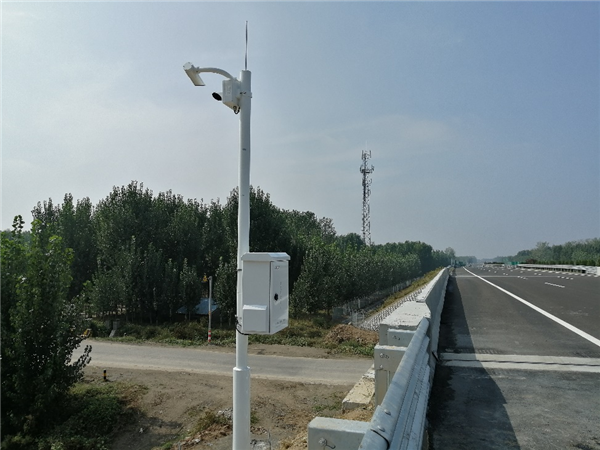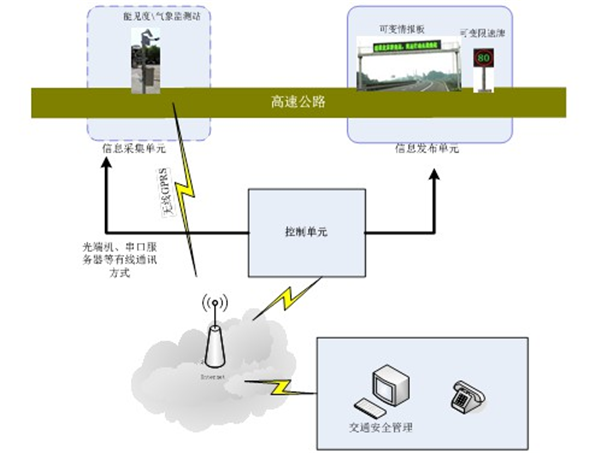
1. Overview
Expressways carry important transportation tasks. With the rapid development of our country's economy in recent years, more and more expressways have been built in various provinces, gradually forming a highway network extending in all directions, providing transportation and people with a convenient way to travel. Very convenient. However, bad weather such as heavy fog and smog often triggers serious traffic accidents in which multiple vehicles collide head-to-head. Affected by bad weather such as haze and haze, there are huge risks for vehicles driving on highways. Therefore, it is particularly important to enhance the adaptability to severe weather and improve highway traffic safety.
The traffic flow on the expressway is fast and large, and its characteristics of being fully enclosed and fully interchanged require that vehicles are not allowed to slow down and stop arbitrarily. Therefore, once an accident occurs on the expressway in foggy weather, it will often cause a chain reaction, eventually leading to multiple vehicles in a row. of catastrophic traffic accidents. It is extremely important to strengthen traffic control in severe weather, especially in foggy weather. Therefore, visibility information monitoring technology in highway fog areas is an effective means of highway traffic control in foggy weather.
2. Technical Standards (Specifications) Mainly Used In Design
(1) "Regulations on the Implementation of the Road Traffic Safety Law of the People's Republic of China"
(2) Meteorological industry standard "Highway Visibility Monitoring and Dense Fog Warning and Forecasting" (QX/T 76-2007).
(3) "Highway Traffic Meteorological Condition Levels" (draft for comments).
(4) "Road Traffic Meteorological Environment Visibility Detector" (JT/T714-2008).
3. Classification of Dense Fog Levels on Highways
In the "Highway Visibility Monitoring and Early Warning and Forecasting of Dense Fog" industry standard, according to the regulations on the operation and management of expressways under severe weather conditions, combined with the visibility monitoring and early warning and forecast test research of the meteorological department, the conditions that will affect the operation of the expressway are Visibility is recommended to be divided into the following five levels:
Level 0 > 500 m does not require any measures
General control measures will be adopted at Level 1 500-200 m, and the speed of operating vehicles will be limited.
Level 2 200-100 m will strengthen inspections, take control measures, and strictly limit vehicle speeds
Level 3 100-50 m inspections will be strengthened, strict speed limits and diversion measures will be adopted, and some road sections will be closed.
Level 4 <50 m road closure and suspension of operations
4. Regulations for the Implementation of the Traffic Safety Law on Visibility
The Implementation Regulations of the Road Traffic Safety Law of the People's Republic of China (Article 81) requires:
Motor vehicles driving on highways must comply with the following regulations when encountering low-visibility weather conditions such as fog, rain, snow, sand, hail, etc.:
(1) When the visibility is less than 200 meters, turn on the fog lights, low beam lights, position lights and front and rear position lights, the vehicle speed must not exceed 60 kilometers per hour, and keep a distance of more than 100 meters from the vehicle ahead in the same lane;
(2) When visibility is less than 100 meters, turn on fog lights, low beam lights, position lights, front and rear position lights and hazard warning flashers, the vehicle speed must not exceed 40 kilometers per hour, and keep a distance of more than 50 meters from the vehicle ahead in the same lane;
(3) When the visibility is less than 50 meters, turn on the fog lights, low beam lights, position lights, front and rear position lights and hazard warning flashers. The vehicle speed must not exceed 20 kilometers per hour, and leave the highway as soon as possible from the nearest exit.
When encountering the circumstances specified in the preceding paragraph, the expressway management department shall issue prompt information such as speed limits and distance between vehicles through display screens and other means.
5. System Composition
The highway fog area visibility information monitoring system belongs to the fog area information collection unit, which coordinates with the information release unit and the system control unit, and transmits the visibility information to the monitoring center (traffic safety management) in real time for real-time decision-making and control. The fog area information collection unit is the basic unit, and the information release unit and system control unit are system expansion units.
The fog area information collection unit is the core of this solution, mainly composed of visibility detector, power supply unit, communication unit and software. The system is constructed using a network operation mode to continuously obtain visibility meteorological information from multiple points along the route, and can complete the summary and distribution of similar data through remote transmission and transmit it to the traffic safety management department in a timely manner.


System topology diagram
6. Highway Fog Area Monitoring and Warning Linkage
To maximize the effectiveness of visibility information monitoring equipment, the highway emergency command system must be used to realize the linkage of data detection and plan implementation, and coordinate the traffic guidance and traffic control of the entire road network.
It can rely on the variable speed limit signs installed on the highway and control the speed limit value of each speed limit sign in real time according to the visibility distance detected on different road sections. In this way, the system can not only promptly remind the driver to pay attention to the heavy fog ahead, but also Driver safety speed.
Relying on the variable information board facilities installed on the highway, through on-site warning linkage, it more directly guides drivers to drive carefully, keep distance between vehicles, and safely pass through fog areas.